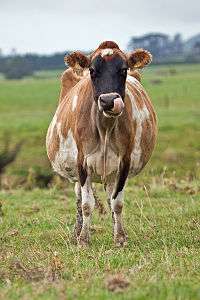Food safety in New Zealand
Food safety in New Zealand is a concern by the general public and the Government takes measures to regulate it. The estimated cost to the country in 2009 of the six foodborne illnesses campylobacteriosis, salmonellosis, norovirus, yersiniosis, STEC and listeriosis was NZ$161 million.[1]

The Government launched an annual Foodsafe Week in 2007 to highlight food safety issues.[2]
Policy
The Food Act 2014 is the primary legislation for governing food safety in New Zealand and is administered by the Ministry for Primary Industries, an amalgamation of the Ministry of Agriculture and Forestry, the Ministry of Fisheries, and the New Zealand Food Safety Authority (now all defunct). This act supersedes the Food Act 1981 and makes some fundamental changes to New Zealand's domestic food regulatory regime. The new act is primarily designed to drive an export led economic recovery for New Zealand, because the domestic food regulatory regime is the platform for exports.
The Food Standards Australia New Zealand develops food standards after consulting with other government agencies and stakeholders.
The Minister of Food Safety is Nikki Kaye.
Incidents
Major food safety incidents are rare but New Zealand was implicated in the 2008 Chinese milk scandal. Fonterra, New Zealand's largest dairy company, had a 43% stake in one of the affected companies. In another recent incident Fonterra found traces of DCD (2-Cyanoguanidine) in milk supplies. The levels were very low and attempts were made to prevent the test results from being reported in the media.[3]
Genetic engineering
The safety of genetically modified foods and ingredients has often been questioned, particularly since the wide-scale discussion and protests in the early 2000s.
Pesticide residue
Pesticide residues are generally low and are thought to pose no detectable threat to health.[4] The Soil & Health Association of New Zealand and the Pesticide Action Network Aotearoa New Zealand claim that the 2010 results for pesticide residue are the worst ever.[5]
References
- Gadiel, David (November 2010). The economic cost of foodborne disease in New Zealand (PDF) (Report). Applied Economics Pty Ltd for the New Zealand Food Safety. Retrieved 13 April 2013.
- "Food Safety Minister Lianne Dalziel launches Foodsafe Week". 12 November 2007. Retrieved 12 April 2013.
- Watkins, Tracy (14 April 2013). "Secrecy Over DCD In Milk Scare Revealed". Sunday Star-Times. Retrieved 13 April 2013.
- Taylor, Rowan; New Zealand (1997). The State of New Zealand's Environment 1997. Wellington, N.Z: Ministry for the Environment. ISBN 0-478-09000-5.
- "Pesticide Residues in Food – Worst Ever". Soil & Health Association of New Zealand Inc. 28 June 2010. Retrieved 29 July 2010.
External links
- Ministry for Primary Industries
- Food safety portal - for industry
- Food smart portal - for consumers
- Food at the Ministry of Health
- Food safety portfolio news at The Beehive
- Food safety - a briefing for government ministers (2000)
- Food Standards Australia New Zealand
- Food safety at the New Zealand Nutrition Foundation